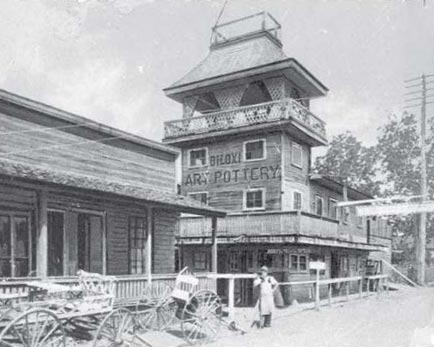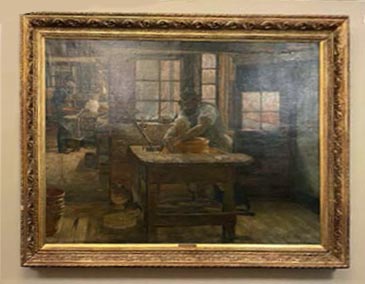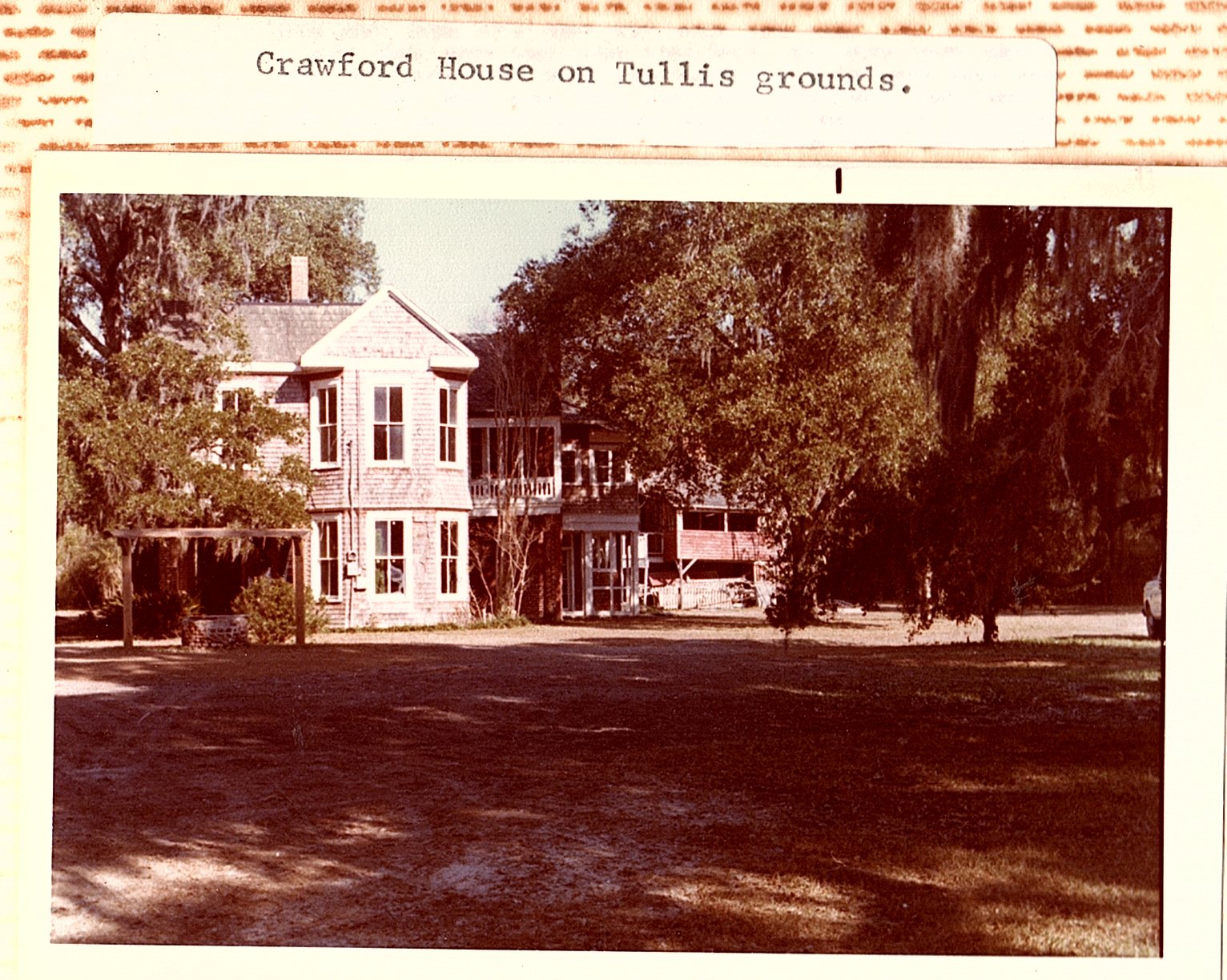
Article originally written by Jane Shambra, a local Biloxi writer, for BNews Monthly, the monthly newsletter of the City of Biloxi. All images courtesy of the Local History and Genealogy Department / Biloxi Public Library / Harrison County Library System.
Biloxi is filled with history and what better way to tell the culture of Biloxi than through the artistic works of talented residents. Let’s take a look at just a small portion of the skilled artists Biloxi has produced over the years.
The Mad Potter
 George E. Ohr, known as the Mad Potter, was born in Biloxi in 1857. He is one of Biloxi’s most renowned artists and is recognized worldwide for his unique pottery.
George E. Ohr, known as the Mad Potter, was born in Biloxi in 1857. He is one of Biloxi’s most renowned artists and is recognized worldwide for his unique pottery.
George’s art studio was once located in downtown Biloxi on Delauney Street just north of Howard Avenue. There he created vessels of all types, e.g., cups, vases, bowls, pitchers, and utilized clay from Biloxi’s Tchoutacabouffa River. George held steadfast to his motto: “no two alike.”
In 1909, he retired from his pottery wheel and his sons opened up the first auto repair place in the area of his old workshop.
George died in 1918 of throat cancer at age 60 and is buried in the Old Biloxi Cemetery. The three-block portion of Delauney Street stemming from Hwy. 90 was renamed the G E Ohr Street in his memory.
 Also in his memory, in 1994 the first
George E. Ohr Arts and Cultural Center
opened in the previous Biloxi Library
building situated between Lameuse and G.E. Ohr streets, and today, the
expanded Ohr Museum is known as the
Ohr-O’Keefe Museum of Art (OOMA).
It was designed by architect Frank
Gehry and opened in 2010. The
OOMA campus is comprised of several
buildings and offers displays, art
classes, summer camps, events, outdoor
movies, and a museum shop.
Also in his memory, in 1994 the first
George E. Ohr Arts and Cultural Center
opened in the previous Biloxi Library
building situated between Lameuse and G.E. Ohr streets, and today, the
expanded Ohr Museum is known as the
Ohr-O’Keefe Museum of Art (OOMA).
It was designed by architect Frank
Gehry and opened in 2010. The
OOMA campus is comprised of several
buildings and offers displays, art
classes, summer camps, events, outdoor
movies, and a museum shop.
Over at Biloxi City Hall, an 1890 painting by another famous Biloxi resident, Professor William Woodward, depicting George Ohr and his teacher and mentor Joseph Meyer hangs in the lobby of the second floor.
Monumental metal
In 1977, the Biloxi Library and Cultural Center building opened on Lameuse Street just across the street from Biloxi’s City Hall. At the G. E. Ohr Street entrance of the Cultural Center once stood an iconic metal sculpture by Betty Gold. It was titled Monumental Holistic XXI and was installed outdoors adjacent to the facility’s entrance in 1982.
In 2005, Hurricane Katrina hit Biloxi
and destroyed the building, but Betty’s
sculpture survived. It was later moved
to the grounds of Biloxi’s Community
Development Department’s building, which
was much higher ground and away from
the wrecking ball.
The abstract painter
 Dusti Bonge (nee Eunice Lyle Swetman)
was born and raised in Biloxi on West
Howard Avenue. She was a painter who
was influenced strongly by the cities of Biloxi, New Orleans, and New York.
Dusti Bonge (nee Eunice Lyle Swetman)
was born and raised in Biloxi on West
Howard Avenue. She was a painter who
was influenced strongly by the cities of Biloxi, New Orleans, and New York.
Dusti is known as Mississippi’s first abstract painter. She passed away in 1993 but her legacy lives on through the mission of the Dusti Bonge Art Foundation, located just north of the OOMA campus in the 100-plus-year-old, well-restored Creel House.
Fisherman’s art
 Once located on the east side of Porter Avenue adjacent to the present Biloxi Visitors Center, was the Moran’s Art Studio.
It was an amazing contribution to local art
and Colonial history through the years.
Once located on the east side of Porter Avenue adjacent to the present Biloxi Visitors Center, was the Moran’s Art Studio.
It was an amazing contribution to local art
and Colonial history through the years.
Born in 1915, Joseph W. Moran began his successful career at a very early age, when he first worked with the design and construction of boats. His talent led him to the acclaimed creation of racing crafts that won many speed records.
In the 1950s, Joe operated a business at the studio location: Joe Moran Boats and Equipment Co. His ability to pay attention to intricate detail led him to express his boat concepts onto canvas, utilizing oil paints and creating life-like marine and landscape scenery. Joe Moran’s talents must have been inherited since he was also the grandson of Biloxi’s famous potter, George Ohr.
In the mid-1960s, Moran’s Studio and Art Workshop was offering art instruction classes in the use of color in oil paintings. Hurricane Camille visited his studio in August 1969 provoking a new twist to his Studio’s future years revealing an unanticipated find. By November 1969, a dozen human skeletons had been discovered under his raised structure, providing a new puzzle to renovation efforts.
The discovery of old bones was, apparently not new to the area. An older newspaper story printed in May 1914 reported a previous revelation of human skeletal remains, as well. The 1914 bones were immediately reburied and were assumed to be of Native American descent.
As part of the renovation, Joe designed a glass enclosure on the renovated flooring to exhibit these unexpected findings. Thus, the Studio became not only a source for artwork and supplies but a mini-museum and tourist attraction.
At that time, and without today’s technology to rely upon, it was assumed that these burials could have been dated back as far as 2200 B.C.
In 2005, Hurricane Katrina devastated the studio, and many more skeletal remains were discovered. With the assistance of archaeological experts, it was concluded that the burials were mostly young adults who had been afflicted with malnutrition, and diseases, such as rickets. Today, this site is known as the French Colonial Memorial Garden and is accompanied by a historical marker and interpretive signage.

The visiting artist
Perhaps one of Biloxi’s least known, but most outstanding artist is Josephine Crawford. Born to French-speaking parents in the New Orleans French Quarter, she didn’t take her work seriously until she was in her mid-forties. Josephine was well educated and was able to learn, read, and write in both French and English. This artist studied the intricacies of art both in New Orleans and in Europe.
Josephine was a frequent occupant of a famous shingle house once located
on the eastern end of the Tullis property
in Biloxi. Certainly, she was artistically
inspired by the perfect setting of the
Mississippi Sound, the seafood factories,
the beachfront lure, the chirping birds,
and the serene atmosphere of her family’s
waterfront home. Josephine was quite
aware of Biloxi’s visiting insects and some
of her paintings included the famous
mosquito net protecting her subjects.
To find out more about Biloxi’s artists throughout history, visit the Biloxi Library’s Local History and Genealogy Department which has an amazing array of resources. Who knows, it could spark the beginning of another Biloxi artist.
###
Click here to order mouthwatering wild-caught shrimp straight from the warm waters of the Gulf of Mexico.
